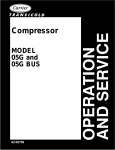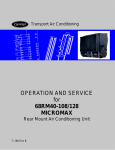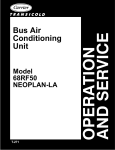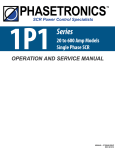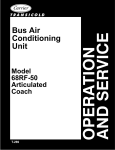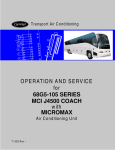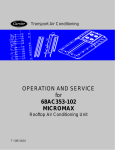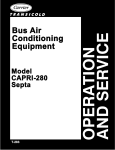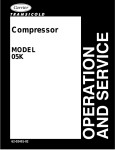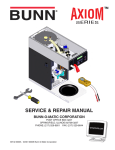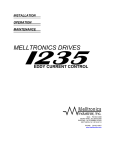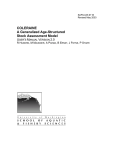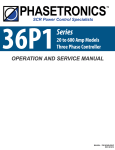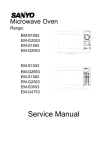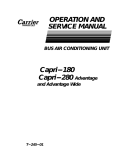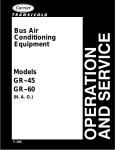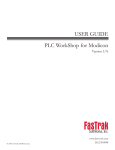Download Bus Air Conditioning Unit - North America Transport Air Conditioning
Transcript
Bus Air Conditioning Unit Rearmount 68RM40-504 68RM40-514 68RM40-524 T-250 OPERATION AND SERVICE MANUAL BUS AIR CONDITIONING UNIT Rearmount 68RM40-504 68RM40-514 68RM40-524 Carrier Transicold Division, Carrier Corporation, P.O. Box 4805, Syracuse, N.Y. 13221 Carrier Corporation 1993 D Printed in U. S. A. 0493 TABLE OF CONTENTS Section Page 1 1.1 1.2 1.3 1.4 1.5 1.6 1.7 DESCRIPTION . . . . . . . . . . . . . . . . . . . . . . . . . . . . . . . . . . . . . . . . . . . . . . . . . . . . . . . . . Introduction . . . . . . . . . . . . . . . . . . . . . . . . . . . . . . . . . . . . . . . . . . . . . . . . . . . . . . . . . . . . Refrigeration System Component Specifications . . . . . . . . . . . . . . . . . . . . . . . . . . . . . . Electrical Specifications . . . . . . . . . . . . . . . . . . . . . . . . . . . . . . . . . . . . . . . . . . . . . . . . . . . Safety Devices . . . . . . . . . . . . . . . . . . . . . . . . . . . . . . . . . . . . . . . . . . . . . . . . . . . . . . . . . . . System Operating Controls and Components . . . . . . . . . . . . . . . . . . . . . . . . . . . . . . . . . Heater Flow Cycle . . . . . . . . . . . . . . . . . . . . . . . . . . . . . . . . . . . . . . . . . . . . . . . . . . . . . . . Air Conditioning Refrigerant Cycle . . . . . . . . . . . . . . . . . . . . . . . . . . . . . . . . . . . . . . . . . 1-1 1-1 1-5 1-5 1-6 1-7 1-7 1-8 2 2.1 2.2 2.3 OPERATION . . . . . . . . . . . . . . . . . . . . . . . . . . . . . . . . . . . . . . . . . . . . . . . . . . . . . . . . . . . Pre-trip Inspection . . . . . . . . . . . . . . . . . . . . . . . . . . . . . . . . . . . . . . . . . . . . . . . . . . . . . . . Starting and Stopping Instructions . . . . . . . . . . . . . . . . . . . . . . . . . . . . . . . . . . . . . . . . . . Control Circuit . . . . . . . . . . . . . . . . . . . . . . . . . . . . . . . . . . . . . . . . . . . . . . . . . . . . . . . . . . 2.3.1 Air Conditioning Circuit Operation . . . . . . . . . . . . . . . . . . . . . . . . . . . . . . . . . . 2.3.2 Ventilation Circuit Operation . . . . . . . . . . . . . . . . . . . . . . . . . . . . . . . . . . . . . . . 2.3.3 Heating Operation . . . . . . . . . . . . . . . . . . . . . . . . . . . . . . . . . . . . . . . . . . . . . . . . 2-1 2-1 2-1 2-1 2-1 2-2 2-2 3 3.1 3.2 3.3 3.4 TROUBLESHOOTING . . . . . . . . . . . . . . . . . . . . . . . . . . . . . . . . . . . . . . . . . . . . . . . . . . . Unit Will Not Cool . . . . . . . . . . . . . . . . . . . . . . . . . . . . . . . . . . . . . . . . . . . . . . . . . . . . . . . Unit Runs But has Insufficient Cooling . . . . . . . . . . . . . . . . . . . . . . . . . . . . . . . . . . . . . . Abnormal Pressure . . . . . . . . . . . . . . . . . . . . . . . . . . . . . . . . . . . . . . . . . . . . . . . . . . . . . . . Abnormal Noise and Vibrations . . . . . . . . . . . . . . . . . . . . . . . . . . . . . . . . . . . . . . . . . . . . 3.4.1 Abnormal Noise . . . . . . . . . . . . . . . . . . . . . . . . . . . . . . . . . . . . . . . . . . . . . . . . . . 3.4.2 Abnormal Vibration . . . . . . . . . . . . . . . . . . . . . . . . . . . . . . . . . . . . . . . . . . . . . . . Temperature Controller Malfunction . . . . . . . . . . . . . . . . . . . . . . . . . . . . . . . . . . . . . . . . No Evaporator Air Flow or Restricted Air Flow . . . . . . . . . . . . . . . . . . . . . . . . . . . . . . Expansion Valve Malfunction . . . . . . . . . . . . . . . . . . . . . . . . . . . . . . . . . . . . . . . . . . . . . . 3-1 3-1 3-1 3-1 3-2 3-2 3-2 3-2 3-2 3-2 SERVICE . . . . . . . . . . . . . . . . . . . . . . . . . . . . . . . . . . . . . . . . . . . . . . . . . . . . . . . . . . . . . . . Maintenance Schedule . . . . . . . . . . . . . . . . . . . . . . . . . . . . . . . . . . . . . . . . . . . . . . . . . . . . Installing Manifold Gauges . . . . . . . . . . . . . . . . . . . . . . . . . . . . . . . . . . . . . . . . . . . . . . . . Pumping The System Down or Removing The Refrigerant Charge . . . . . . . . . . . . . . . 4.3.1 System Pump Down . . . . . . . . . . . . . . . . . . . . . . . . . . . . . . . . . . . . . . . . . . . . . . . 4.3.2 Removing the Refrigerant Charge . . . . . . . . . . . . . . . . . . . . . . . . . . . . . . . . . . . Refrigerant Leak Check . . . . . . . . . . . . . . . . . . . . . . . . . . . . . . . . . . . . . . . . . . . . . . . . . . . Evacuation and Dehydration . . . . . . . . . . . . . . . . . . . . . . . . . . . . . . . . . . . . . . . . . . . . . . Adding Refrigerant To System . . . . . . . . . . . . . . . . . . . . . . . . . . . . . . . . . . . . . . . . . . . . . 4.6.1 Adding Full Charge . . . . . . . . . . . . . . . . . . . . . . . . . . . . . . . . . . . . . . . . . . . . . . . 4.6.2 Adding Partial Charge . . . . . . . . . . . . . . . . . . . . . . . . . . . . . . . . . . . . . . . . . . . . . Checking For Noncondensibles . . . . . . . . . . . . . . . . . . . . . . . . . . . . . . . . . . . . . . . . . . . . . Checking and Replacing High or Low Pressure Cutout Switch . . . . . . . . . . . . . . . . . . . 4.8.1 Replacing High or Low Pressure Switch . . . . . . . . . . . . . . . . . . . . . . . . . . . . . . 4.8.2 Checking High or Low Pressure Switch . . . . . . . . . . . . . . . . . . . . . . . . . . . . . . . Filter-drier . . . . . . . . . . . . . . . . . . . . . . . . . . . . . . . . . . . . . . . . . . . . . . . . . . . . . . . . . . . . . . Thermostatic Expansion Valve . . . . . . . . . . . . . . . . . . . . . . . . . . . . . . . . . . . . . . . . . . . . . 05G Compressor Maintenance . . . . . . . . . . . . . . . . . . . . . . . . . . . . . . . . . . . . . . . . . . . . . 4.11.1 Removing the Compressor . . . . . . . . . . . . . . . . . . . . . . . . . . . . . . . . . . . . . . . . . . 4.11.2 Compressor Oil Level . . . . . . . . . . . . . . . . . . . . . . . . . . . . . . . . . . . . . . . . . . . . . . Servicing Pressure Actuated Compressor Unloader (If Equipped) . . . . . . . . . . . . . . . Electrical Compressor Unloader (If Equipped) . . . . . . . . . . . . . . . . . . . . . . . . . . . . . . . 4-1 4-1 4-1 4-2 4-2 4-2 4-2 4-2 4-3 4-3 4-3 4-4 4-4 4-4 4-4 4-4 4-5 4-5 4-5 4-6 4-7 4-8 3.5 3.6 3.7 4 4.1 4.2 4.3 4.4 4.5 4.6 4.7 4.8 4.9 4.10 4.11 4.12 4.13 i TABLE OF CONTENTS (CONT’D) Section 5 5.1 Page ELECTRICAL SCHEMATIC WIRING DIAGRAM Introduction . . . . . . . . . . . . . . . . . . . . . . . . . . . . . . . . . . . . . . . . . . . . . . . . . . . . . . . . . . . . 5-1 LIST OF ILLUSTRATIONS Figure 1-1 1-2 1-3 1-4 1-5 Unit Assembly --- Back View . . . . . . . . . . . . . . . . . . . . . . . . . . . . . . . . . . . . . . . . . . . . . Unit Assembly --- Inside View . . . . . . . . . . . . . . . . . . . . . . . . . . . . . . . . . . . . . . . . . . . . Electrical Component Panel Assembly . . . . . . . . . . . . . . . . . . . . . . . . . . . . . . . . . . . . . Heater Flow Cycle . . . . . . . . . . . . . . . . . . . . . . . . . . . . . . . . . . . . . . . . . . . . . . . . . . . . . . Air Conditioning Cycle . . . . . . . . . . . . . . . . . . . . . . . . . . . . . . . . . . . . . . . . . . . . . . . . . . Page 1-2 1-3 1-4 1-7 1-8 2-1 2-2 2-3 2-4 2-5 2-6 2-7 Unit Control Panel . . . . . . . . . . . . . . . . . . . . . . . . . . . . . . . . . . . . . . . . . . . . . . . . . . . . . Temperature Controller Sequence --- Reheat . . . . . . . . . . . . . . . . . . . . . . . . . . . . . . . . Temperature Controller Sequence --- Cycling Clutch . . . . . . . . . . . . . . . . . . . . . . . . . Air Conditioning Mode --- with Reheat Controller . . . . . . . . . . . . . . . . . . . . . . . . . . . Air Conditioning Mode --- with Clutch Cycling Controller . . . . . . . . . . . . . . . . . . . . Vent Mode --- with Clutch Cycling Controller . . . . . . . . . . . . . . . . . . . . . . . . . . . . . . . Heat Mode --- with Clutch Cycling Controller . . . . . . . . . . . . . . . . . . . . . . . . . . . . . . . 2-1 2-3 2-3 2-4 2-5 2-6 2-7 4-1 4-2 4-3 4-4 4-5 4-6 4-7 Manifold Gauge Set . . . . . . . . . . . . . . . . . . . . . . . . . . . . . . . . . . . . . . . . . . . . . . . . . . . . Vacuum Pump Connections . . . . . . . . . . . . . . . . . . . . . . . . . . . . . . . . . . . . . . . . . . . . . . Checking High Pressure Switch . . . . . . . . . . . . . . . . . . . . . . . . . . . . . . . . . . . . . . . . . . . Thermostatic Expansion Valve . . . . . . . . . . . . . . . . . . . . . . . . . . . . . . . . . . . . . . . . . . . . Removing Bypass Piston Plug . . . . . . . . . . . . . . . . . . . . . . . . . . . . . . . . . . . . . . . . . . . . . O5G Compressor . . . . . . . . . . . . . . . . . . . . . . . . . . . . . . . . . . . . . . . . . . . . . . . . . . . . . . . Electric Unloader Schematic . . . . . . . . . . . . . . . . . . . . . . . . . . . . . . . . . . . . . . . . . . . . . 4-1 4-3 4-4 4-5 4-6 4-6 4-8 5-1 5-2 5-3 5-4 5-5 5-6 5-7 Electrical Schematic Wiring Diagram (Models 68RM40-504 & 524) . . . . . . . . . . . . Electrical Schematic Wiring Diagram (Model 68RM40-504-5) . . . . . . . . . . . . . . . . . Electrical Schematic Wiring Diagram (Model 68RM40-504-3 & 504-7) . . . . . . . . . . Electrical Schematic Wiring Diagram (Model 68RM40-504-13) . . . . . . . . . . . . . . . . Electrical Schematic Wiring Diagram (Model 68RM40-504-27) . . . . . . . . . . . . . . . . Electrical Schematic Wiring Diagram (Model 68RM40-504-23) . . . . . . . . . . . . . . . . Electrical Schematic Wiring Diagram (Model 68RM40-524-11) . . . . . . . . . . . . . . . . 5-2 5-4 5-6 5-8 5-10 5-12 5-14 LIST OF TABLES Table Page 1-1 1-2 Model Chart . . . . . . . . . . . . . . . . . . . . . . . . . . . . . . . . . . . . . . . . . . . . . . . . . . . . . . . . . . . Safety Devices . . . . . . . . . . . . . . . . . . . . . . . . . . . . . . . . . . . . . . . . . . . . . . . . . . . . . . . . . 1-1 1-6 4-1 4-2 R-22 Pressure---Temperature Chart . . . . . . . . . . . . . . . . . . . . . . . . . . . . . . . . . . . . . . . R-134a Temperature---Pressure Chart . . . . . . . . . . . . . . . . . . . . . . . . . . . . . . . . . . . . . . 4-8 4-9 ii SECTION 1 DESCRIPTION 1.1 The RM40 unit interfaces with the bus’s (customer supplied) compressor, driver’s switches, floor heater, water valves and pump to provide a full air conditioning, heating and ventilation system. INTRODUCTION This manual contains Operating and Electrical Data, and Service Instructions for the RM40 Bus Air Conditioning and Heating systems shown in the model below. The RM40 has two types of controllers Cycling Clutch or Reheat. With Cycling Clutch, the compressor cycles on and off to control bus interior temperature. With Reheat, the coolant valve opens or closes on thermostat command to control bus interior temperature while the air conditioning mode continues to operate. The RM40 unit is a one-piece system consisting of a condenser, evaporator, and heater coil assemblies. The unit is installed in the rear A/C compartment of the bus. Table 1-1. Model Chart Model Refrigerant TMC Option Controller RM40-504 RM40-504-1 RM40-504-3 RM40-504-4 RM40-504-5 RM40-504-7 RM40-504-8 RM40-504-9 RM40-504-10 RM40-504-13 RM40-504-23 RM40-504-27 RM40-514 RM40-524 RM40-524-11 R-22 R-22 R-22 R-22 R-22 R-22 R-22 R-22 R-22 R-22 R-22 R-22 NONE R-134a R-134a C71 C72 C74 C74-1 C73 C74 C71-1 C72-1 C74-1 C73 C71-1 C74 CTE C71 C71 Reheat Cycling Clutch Cycling Clutch Cycling Clutch Reheat Cycling Clutch Reheat Cycling Clutch Cycling Clutch Reheat Reheat Cycling Clutch HEAT ONLY Reheat Reheat 1-1 Driver’s Switches (customer supplied) Automatic Automatic 4 Mode 4 Mode 4 Mode 4 Mode Automatic Automatic 4 Mode 4 Mode Automatic 4 Mode --Automatic Automatic 21 21 1 TOP VIEW 1 CURBSIDE (CS) ROADSIDE (RS) 2 1. 2. 3. 4. 3 Condenser Coil Evaporator Blower Shroud Heater Coil (See Figure 1-4) Wire Connection to Main Water Valve Assembly 5. Evaporator Blower Motor 6. Receiver Outlet Valve 7. Filter-Drier 4 5 6 7 8 9 10 11 12 13 14 15 8. 9. 10. 11. 12. 13. Receiver Sight Glass High Pressure Switch Low Pressure Switch Suction Line Service Port Suction Line Connection to Compressor 14. Thermostatic Expansion Valve Figure 1-1. Unit Assembly --- Back View 1-2 16 15. 16. 17. 18. 19. 17 18 19 20 Condenser Fan Switch Filter-Drier Outlet Valve Access Panel Discharge Line Service Port Discharge Line Connection to Compressor 20. Discharge Line Check Valve 21. Condenser Fan Motor 11 1 2 3 4 1. 2. 3. 4. 5. 6. 5 6 7 8 9 10 7. 8. 9. 10. 11. Upper Mounting Bracket 240 Watt Resistor 440 Watt Resistor Evaporator Blower Wheel Lower Mounting Bracket Electrical Panel (See Figure 1-3) Controller Harness Terminal Block Evaporator Air Filter Evaporator Coil 24 V Interface Plug Figure 1-2. Unit Assembly --- Inside View 1-3 1 2 3 4 5 6 7 8 9 C L W 10 B1 #1 11 B2 12 13 20 F H #2 14 #3 15 #4 16 17 #5 18 19 1. Floor Heater Circuit Breaker (CB1) --- 8 Amp 2. Compressor Clutch and Water Pump Circuit Breaker (CB2) --- 15 Amp 3. Evaporator Fan Motor No.1 Circuit Breaker (CB3) --- 35 Amp 4. Evaporator Fan Motor No. 2 Circuit Breaker (CB4) --- 35 Amp 5. Condenser Fan Motor No.1 Circuit Breaker (CB5) --- 50 Amp 6. Condenser Fan Motor No. 2 Circuit Breaker (CB6) --- 50 Amp 7. Evaporator Blower Speed Switch (EBS) 8. Cool Relay (C) 9. Lock-In Relay (L) 10. 11. 12. 13. 14. 15. 16. 17. 18. 19. 20. Water Pump Relay (W) Blower Relay No.1 (B1) Blower Relay No.2 (B2) Floor Blower Relay (F) Motor Contactor #1 (MC1) Low Speed Diode No.4 (D4) Motor Contactor #2 (MC2) High Speed Motor Contactor #3 (MC3) Motor Contactor #4 (MC4) Motor Contactor #5 (MC5) Speed Heat Relay (H) Figure 1-3. Electrical Component Panel Assembly 1-4 --- Evaporator Blower --- Evaporator Blower --- Condenser Fan No.1 --- Condenser Fan No.2 --- Condenser Fan High R-134a Units 1.2 REFRIGERATION SYSTEM COMPONENT SPECIFICATIONS a. Refrigeration Charge R-22 or R-134a: 16 to 17 lb. b. Compressor Model: 05G No. of Cylinder: 6 Weight (Dry): 145 lbs. (66 kg) including clutch Oil Charge: 6.75 pints (3.2 liters) Oil Level: Old Crankcase (before S/N 4994J): Bottom to 1/4 of sight glass New Crankcase (beginning S/N 4994J): Between Min---Max marks on crankcase Approved Compressor Oils ---R-22 Calumet Refining Co.:R030 Texaco : WF68 Witco: 4GS Suniso Approved Compressor Oils ---R-134a Castrol: Icematic SW68C Mobil: EAL Artic 68 ICI: Emkarate RL68H c. 05G Compressor Pressure Unloaders (Optional) Opens at: 300 10 psig (21 .7 kg/cm@) Closes at: 200 10 psig (14 .7 kg/cm@) h. Condenser Fan Switch (CFS) R-22 Units Closes for high speed: 32010 psig (22.5 .7 kg/cm@) Opens for Low Speed: 250 10 psig (17.8 .7 kg/cm@) R-134a Units Closes for high speed: 220 10 psig (15.5 .7 kg/cm@) Opens for Low Speed: 17010 psig (12 .7 kg/cm@) i. Freeze Protection Temperature Switch (FPTS) Opens at: 32 2_F (0_C) Closes at: 38 2_F (3.3_C) PRESSURE UNLOADER First Unloader Second Unloader Refrigerant Load Up Unload Load Up Unload R-22 65 psig 55 psig 60 psig 50 psig R-134a 36 psig 30 psig 30 psig 24 psig j. Water Temperature Switch (WTS) (Customer Supplied) k. Unit Weight d. 05G Compressor Electric Unloaders Pressure Switches UPS1 & UPS2 (Optional) Approximate: 600 lb (272 kg) UNLOADER PRESSURE SWITCH UPS1 UPS2 Refrigerant Load Up Unload Load Up Unload R-22 75 psig 60 psig 65 psig 50 psig 1.3 ELECTRICAL SPECIFICATIONS a. Evaporator/Heater Blower Motor e. Thermostatic Expansion Valve R-22 Units Superheat Setting: 12_F (6.7_C) MOP Setting: 95.5 7 psig (6.7 kg/cm@) R-134a Units Superheat Setting: 10_F (5.6_C) MOP Setting: 53.9 4 psig (3.8 kg/cm@) f. Low Pressure Switch (LPS) Opens at: 6 3 psig (.42 .2 kg/cm@) Closes at: 25 3 psig (2.8 .2 kg/cm@) g. High Pressure Switch (HPS) Bearing Lubrication: Factory Lubricated (additional grease not required) Horsepower: 0.6 (.44 kw) Full Load Amps (FLA): 22 amps Operating Speed: 1200 rpm Voltage: 24 vdc Dropping Resistor (DR1): 240 watts b. Condenser Fan Motor Bearing Lubrication: Factory Lubricated (additional grease not required) Horsepower: 0.5 hp (.37 kw) Full Load Amps (FLA): 18 amps Operating Speed: 1550 rpm Voltage: 24 vdc Dropping Resistor (DR2): 440 watts R-22 Units Opens at: 425 10 psig (30 .7 kg/cm@) Closes at: 300 10 psig (21 .7 kg/cm@) 1-5 During the reheat mode, operation will automatically stop in the same manner as indicated in the A/C, vent or heat modes. 1.4 SAFETY DEVICES System components are protected from damage caused by unsafe operating conditions with safety devices (listed in table Table 1-2). The evaporator, condenser and floor heater motors are protected independently against high current draw with circuit breakers (CB3, 4, 5 & 6). The evaporator and condenser motors are also protected from high temperature with thermal protection switches (IP---CM and IP---EM). If one of the evaporator motor safety devices opens to stop one or both of the motors, low pressure may become present in the system which may cause the low pressure switch (LPS) to open, shutting the unit down. If a condenser motor safety device opens, high pressure may be become present, which may open the high pressure switch (HPS) to shut the unit down. During A/C mode, operation will automatically stop when such unsafe conditions occur, by de-energizing the compressor clutch and condenser motor coils if the Freeze Protection Temperature Switch (FPTS), High Pressure Switch (HPS) or Low Pressure Switch (LPS) opens. The A/C fail lights (ACFL1 & 2) will illuminate to indicate an unsafe condition. The evaporator blower motors will continue to run to circulate the air. When a safety device opens and causes the unit operation to stop, place the climate control switch to off position before resolving the problem. The safety device may need to be manually reset before restarting the unit. During the vent or heat modes, operation will automatically stop if the circuit breaker, CB senses excessive current draw by the TC or one of the operating components. Table 1-2. Safety Devices Unsafe Condition Safety Device Device Setting 1. Excessive current draw by the floor heater blowers. 1. Circuit Breaker --- CB1 Manual Reset 1. Opens at 8 amps 2. Excessive current draw by the water pump or clutch coil. 2. Circuit Breaker --- CB2 Manual Reset 2. Opens at 15 amps 3. Excessive current draw by evaporator motor no.1. 3. Circuit Breaker --- CB3 Manual Reset 3. Opens at 35 amps 4. Excessive current draw by evaporator motor no. 2. 4. Circuit Breaker --- CB4 Manual Reset 4. Opens at 35 amps 5. Excessive current draw by condenser motor no.1. 5. Circuit Breaker --- CB5 Manual Reset 5. Opens at 50 amps 6. Excessive current draw by condenser motor no. 2. 6. Circuit Breaker --- CB6 Manual Reset 6. Opens at 50 amps 7. High compressor discharge pressure. 7. High Pressure Switch (HPS) Manual Reset 7. Refer to Section 1.2 8. Loss of refrigerant charge 8. Low Pressure Switch (LPS) Automatic Reset 8. Opens at 6 ¦ 3 psig (1.9 ¦ .28 kg/cm@) 9. Excessive system pressure in the high side of the system. 9. High pressure relief valve Replace 9. Opens at 450 psig (31.6 kg/cm@) 1-6 experiences excessive temperature, the corresponding EMTH switch will open to de-energize the motor contacts. This will stop both evaporator blower motor. 1.5 SYSTEM OPERATING CONTROLS AND COMPONENTS a. Temperature Controller (Thermostat) There are two types of controllers Cycling Clutch or Reheat. With Cycling Clutch, the compressor cycles on and off to control bus interior temperature. With Reheat, the coolant valve opens or closes on thermostat command to control bus interior temperature while the air conditioning mode continues to operate. Freeze Protection Temperature Switch (FPTS) The Freeze Protection Temperature Switch (FPTS) is located on the relay panel. The sensor is located on evaporator coil. The FPTS protects the coil from frost build-up. The switch opens when coil temperature falls to 30 2_F to de-energize the Lock-in Relay (L). De-energizing the Lock-in Relay will cause the condenser fan motors to stop and drop-out the compressor clutch to stop the refrigerant cycle. At this time only the evaporator blower will continue to run until the coil temperature rises to 38 2_F, at which time the switch will close to continue operation. b. Manual Switches Evaporator Blower Speed Switch (EBS) The manual Evaporator Blower Speed switch (EBS) is located next to the circuit breakers on the electrical component panel (see Figure 1-3). When the EBS switch is closed, the Motor Contact #2 will energize to lock-in the evaporator motors in high speed. d. Pressure Switches Condenser Fan Switch (CFS) The Condenser Fan Switch (CFS) is located on the inlet line to the receiver (next to the filter-drier). If the condenser coil pressure reaches 320 10 psig, the CFS will close to energizes Motor Contactor #5 coil. This will lock the Condenser Motors (CM1 & 2) in high speed until the condenser pressure drops to 250 10 psig, resuming low speed operation. Climate Control Switch (CCS) ---Supplied by OEM The Climate Control Switch (CCS) activates the operation or the unit. This switch is located on the driver’s control panel. When the Climate Control Switch is closed, 24 vdc is fed from the circuit breaker (CB) through the CCS switch to feed power to terminal F of the temperature controller. Defrost Switch (DEF) ---Supplied by OEM 1.6 HEATER FLOW CYCLE Heating is controlled by the thermostat which controls the operation of the water solenoid valve (WSV). When water solenoid valve is energized, the valve will open to allow engine coolant to flow through the heater coil. The Defrost Switch (DEF) when activated will manually place the unit in defrost. When the DEF switch is closed, the Water Valve coil will energize and close a normally open set of contacts to feed 24 vdc to activate Water Pump (WP). This switch when closed during the A/C or Vent mode will override the temperature controller heat relay to activate the water pump. c. Thermal Switches 1 Water Temperature Switch (WTS) ---Supplied by OEM The Water Temperature Switch (WTS) is located on the block of the vehicle engine and senses the vehicles engine coolant temperature. The WTS is a normally closed switch that opens on temperature rise at 120_F (49_C). When the vehicle water temperature is below 120_F, the switch is closed, completing a circuit for the Blower Relays (B1 & B2). Energizing the Blower Relays will prevent the floor blowers and evaporator blowers from activating to prevent the circulation of cooler air throughout the bus during the initial start-up of the vehicle and unit. 2 3 4 5 Condenser Motor Thermal Protectors (CMTH) Each condenser motor is equipped with an internal thermal protector switch. If excessive motor temperature exist, the CMTH switch will open to de-energize the corresponding motor contactor. This will stop the effected condenser motor. 7 1. 2. 3. 4. Evaporator Motor Thermal Protectors (EMTH) Each evaporator blower motor is equipped with an internal thermal protector switch. If either motor 6 Heater Coil Air/Bleed Hose Inlet Tube Air/Bleed Valve 5. Outlet Tube 6. Outlet Hose 7. Inlet Hose Figure 1-4. Heater Flow Cycle 1-7 1.7 AIR CONDITIONING REFRIGERANT CYCLE 4 When air conditioning is selected, the unit operates as a vapor compression system using R-22 or R-134a as a refrigerant. The main components of the system are the reciprocating compressors, air-cooled condenser coil, thermostatic expansion valve, and evaporator coil. The compressors raise the pressure and the temperature of the refrigerant and forces it into the condenser tubes. The condenser fan circulates surrounding air (which is a temperature lower than the refrigerant) over the outside of the condenser tubes. Heat transfer is established from the refrigerant (inside the tubes) to the condenser air (flowing over the tubes). The condenser tubes have fins designed to improve the transfer of heat from the refrigerant gas to the air. This removal of heat causes the refrigerant to liquefy; thus liquid refrigerant leaves the condenser and flows to the receiver. 10 9 7 The receiver serves as a liquid refrigerant reservoir so that a constant supply of liquid is available to the evaporator as needed and as a storage space when pumping down the system. The receiver is equipped with a sight glass to observe the refrigerant for restricted flow and correct charge level. 8 6 3 5 11 The refrigerant leaves the receiver and flows through the manual receiver outlet valve and through a filter-drier where an absorbent keeps the refrigerant clean and dry. 1 The liquid then flows to a thermostatic expansion valve which reduces pressure and temperature of the liquid and meters the flow of liquid refrigerant to the evaporator to obtain maximum use of the evaporator heat transfer surface. 1. 2. 3. 4. 5. 6. 7. 8. 9. 10. 11. The low pressure, low temperature liquid that flows into the evaporator tubes is colder than the air that is circulated over the evaporator tubes by the evaporator blower. Heat transfer is established from the evaporator air (flowing over the tubes) to the refrigerant (inside the tubes). The evaporator tubes have aluminum fins to increase heat transfer from the air to the refrigerant; therefore the cooler air is circulated to the interior of the bus. The transfer of heat from the air to the low temperature liquid refrigerant in the evaporator causes the liquid to vaporize. This low temperature, low pressure vapor passes through the suction line. The low pressure refrigerant vapor is now drawn into the compressor where the cycle repeats. When ventilation only is selected only the evaporator blowers function to circulate air throughout the bus. The refrigerant cycle will remain off. 1-8 Compressor Discharge Line Discharge Line Check Valve Condenser Coil Receiver Filter-Drier Inlet Service Valve Filter-Drier Filter-Drier Outlet Service Valve Thermostatic Expansion Valve Evaporator Coil Suction Line Figure 1-5. Air Conditioning Cycle 2 SECTION 2 OPERATION 2.3 Control Circuit The unit control circuit is 24 vdc supplied by the bus. 2.1 PRE-TRIP INSPECTION After starting unit allow system to stabilize (10 to 15 minutes) and proceed as follows: 2.3.1 Air Conditioning Circuit Operation When the climate control switch is placed in the ON position, 24 vdc power is supplied through the switch to terminal “F” of the temperature controller. With the return air above 74_F, the controller will energize the A/C relay to close a set of normally open contacts. This will send power to the A/C terminal “C” of the controller. From C the following relays will energizes: 1. Listen for abnormal noises. (Refer to section 3.4) 2. Check compressor oil level. 3. Check refrigerant level. a. Lock-in Relay (L) Power will be supplied through the Low Temperature Switch and the High and Low Pressure Switches to energize the Lock-in Relay (L). Energizing the the L relay will close a set of normally open L contacts to allow power to energize the Cool Relay (C) and Condenser Fan Motor Contactor Relay MC3 and MC4. 2.2 STARTING AND STOPPING INSTRUCTIONS a. Starting 1. Start the vehicle engine. 2. Place the climate control switch in the ON position. b. Cool Relay (C) Energizing the Cool Relay (C) will close a set of normally open C contacts to activate the compressor clutch coil. This will start the refrigerant cycle. b. Stopping 1. Place the climate control switch in the OFF position. c. Motor Contactor Relay --- MC3 Energizing the Motor Contactor Relay (MC3) will close a set of normally open MC3 contacts to start the Condenser Fan Motor CM1. NOTE Be sure air conditioning unit is turned off before stopping the engine. d. Motor Contactor Relay --- MC4 Energizing the Motor Contactor Relay (MC4) will close a set of normally open MC4 contacts to start Condenser Fan Motor CM1 (low speed). e. Motor Contactor Relay --- MC5 When the Condenser Fan Switch closes the Motor Contactor Relay (MC5) will energizes and close a set of normally open MC5 contacats to put Condenser Fan Motors CM1 & CM2 in high speed. (Refer to section 1.2 for CFS settings.) AUTOMATIC DRIVER CLIMATE CONTROL SWITCH f. Motor Contactor Relay --- MC2 Energizing the Motor Contactor Relay (MC2) will close a set of normally open MC2 contacats to put Evaporator Fan Motors EM1 & EM2 in high speed. g. Motor Contactor Relay --- MC1 Motor Contactor Relay MC1 will be energized through a normally closed set of Blower Relay Contacts (B2). Evaporator Fan Motors EM1 & EM2. The energized MC1 relay will close a set of normally open MC1 contacts to start the Evaporator Fan Motors (EM1 & EM2) (low speed). DRIVER SELECT CLIMATE CONTROL SWITCH If high pressure occures in the system the High Pressure Switch (HPS) will cut out to open the circuit to Figure 2-1. Unit Control Panel 2-1 the compressor contact to stop the compressor and refrigerant flow. When the compressor shuts down due to a safety device opening, the evaporator blower motors will continue to run untill the A/C switch is placed in the OFF position NOTE If the unit shuts down due to high current, the circuit must be manually reset by pushing the main circuit breaker (CB). TEMPERATURE CONTROLLER (TC) WITH REHEAT TC TERMINALS OPERATING MODE B C D E Air Conditioning Vent Reheat Heat TEMPERATURE CONTROLLER (TC) WITH CYCLING CLUTCH TC TERMINALS OPERATING MODE B C D E Air Conditioning Vent Heat H NOTE: Terminal “F” is input and terminal “A” is ground for the TC. Power supplied from TC to Terminal NO Power from TC With the Reheat controller, the water pump and valve will cycle on and off during the reheat mode. With the Cycling Clutch controller, the compressor clutch will cycle on and off during the reheat mode. 2.3.2 Ventilation Circuit Operation 24 vdc flows through the main circuit breaker (CB) to the Vent Switch. When the Vent switch is placed in the VENT position, 24 vdc power is fed from the switch to energizes the Motor Contactors (MC1 & MC2). Energizing the MC will close a set of normally open MC contacts to allow power to start the Evaporator Blower Motors (EM). 2.3.3 Heating Operation 24 vdc flows through the main circuit breaker (CB) to the Heat Switch. When the Heat switch is placed in the HEAT position, 24 vdc power is fed from the switch to temperature controller (TC). 2-2 AIR CONDITIONING High Speed Blowers AIR CONDITIONING High Speed Blowers 74_¦ 2_F REHEAT & AIR CONDITIONING High Speed Blowers VENT ONLY Low Speed Blowers 70_¦ 2_F HEAT Low Speed Blowers HEAT Low Speed Blowers Temperature Rise Temperature Fall Figure 2-2. Temperature Controller Sequence --- REHEAT AIR CONDITIONING High Speed Blowers AIR CONDITIONING High Speed Blowers 74_¦ 2_F VENT ONLY Low Speed Blowers VENT ONLY Low Speed Blowers 70_¦ 2_F HEAT Low Speed Blowers HEAT Low Speed Blowers Temperature Rise Temperature Fall Figure 2-3. Temperature Controller Sequence --- CYCLING CLUTCH 2-3 = Energized Circuit = De-energized Circuit Figure 2-4. Air Conditioning Mode --- with Reheat Controller 2-4 = Energized Circuit = De-energized Circuit Figure 2-5. Air Conditioning Mode --- with Clutch Cycling Controller 2-5 = Energized Circuit = De-energized Circuit Figure 2-6. Vent Mode --- with Clutch Cycling Controller 2-6 = Energized Circuit = De-energized Circuit Figure 2-7. Heat Mode --- with Clutch Cycling Controller 2-7 SECTION 3 TROUBLESHOOTING INDICATION/ TROUBLE POSSIBLE CAUSES REFERENCE SECTION 3.1 UNIT WILL NOT COOL Compressor will not run F5 Fuse defective R5 Relay defective V-Belt defective Compressor malfunction Clutch malfunction Safety device open Check/Replace Check/Replace Check See Note Check/Replace 1.4 3.2 UNIT RUNS BUT HAS INSUFFICIENT COOLING Compressor Compressor valves defective V-belt loose See Note Check Refrigeration system Abnormal pressures No or restricted evaporator air flow Expansion valve malfunction Restricted refrigerant flow NO TAG 3.6 3.7 4.9 High discharge pressure Refrigerant overcharge Noncondensibles in system Condenser fan motor rotation incorrect Condenser coil dirty R6 & R7 Relays defective F6 & F7 Fuses defective 4.3 4.7 Check Clean Check Check Low discharge pressure Compressor valves(s) worn or broken Low refrigerant charge See Note 4.4 & 4.6 High suction pressure Compressor valves worn or broken See Note Low suction pressure Suction service valve partially closed Receiver outlet valve partially closed Filter-drier partially plugged Low refrigerant charge Expansion valve malfunction Restricted air flow Open Open 4.9 4.4 & 4.6 3.7 Check Low evaporator air flow Blower running in reverse Dirty air filter Icing of coil Check Clean Clean Suction and discharge pressures tend to equalize when unit is operating Compressor valves defective See Note 3.3 ABNORMAL PRESSURE NOTE: Refer to 05G Compressor manual, Form T-199. 3-1 3.4 ABNORMAL NOISE AND VIBRATIONS INDICATION/ 3.4.1 ABNORMAL NOISE TROUBLE POSSIBLE CAUSES Compressor Loose mounting bolts Worn bearings Worn or broken valves Liquid slugging Insufficient oil Clutch loose or rubbing Condenser or Evaporator fan REFERENCE SECTION See Note See Note See Note 3.7 4.11.2 Check Loose or defective Bearings Blade Interference Blade broken or missing Check /Adjust Replace Check Check Compressor Loose mounting bolts 3.4.1 Evaporator or Condenser fan Bent shaft on motor Blade broken or missing Replace motor Check 3.4.2 ABNORMAL VIBRATION 3.5 TEMPERATURE CONTROLLER MALFUNCTION Will not control Controller defective Sensor defective Defective wiring Replace Replace Check 3.6 NO EVAPORATOR AIR FLOW OR RESTRICTED AIR FLOW No evaporator air flow Motor burnout Fan damage Brushes defective Return air filter dirty R1 & R3 Relays defective F1 & F3 Fuses defective Wiring polarity incorrect Replace Replace Replace Check Check Check Section 5 3.7 EXPANSION VALVE MALFUNCTION Low suction pressure with high superheat Low refrigerant charge Wax, oil or dirt plugging valve orifice Ice formation at valve seat Superheat setting too high Power assembly failure Loss of bulb charge Broken capillary Loose bulb 4.4 & 4.6 Check 4.5 4.10 Replace Replace 4.10 Check Low superheat and liquid slugging in compressor Superheat setting too low Ice holding valve open Foreign material in valve 4.10 4.10 4.10 Pin and seat of expansion valve eroded or held open by foreign material Broken capillary 4.10 4.10 Improper bulb location or loose bulb installation Low superheat setting 4.10 4.10 Fluctuating suction pressure NOTE: Refer to 05G Compressor manual, Form T-199. 3-2 SECTION 4 SERVICE WARNING Beware of rotating fan blades and unannounced starting of fans. 4.1 MAINTENANCE SCHEDULE UNIT ON REFERENCE SECTION OPERATION OFF a. Daily Maintenance X X Pre-trip inspection --- after starting Check tension and condition of V-belt(s) 2.1 None b. Weekly Inspection and Maintenance X X X X Perform daily inspection Check condenser, evaporator coils and air filters Check refrigerant hoses and compressor shaft seal for leaks Feel filter-drier for excessive temperature drop across drier. 4.1.1 None 4.4 4.9 c. Monthly Inspection and Maintenance X X X X X X Perform weekly inspection and maintenance Clean evaporator drain pan and hose(s) Check wire harness for chafing and loose terminals Check fan motor bearings Check compressor mounting bolts for tightness Check fan motor brushes 4.1.2 None Replace/Tighten None None None the system can be charged or evacuated. Oil can also be added to the system. 4.2 INSTALLING MANIFOLD GAUGES The manifold gauge set can be used to determine system operation pressure, add charge, equalize or evacuate the system. Low Pressure High Pressure Gauge Gauge a. Installing the Manifold Gauge Set 1. Remove both service valve stems and service port caps. Backseat (counter clockwise) both service valves. 2. Connect the high side hose tightly to discharge service valve port. Hand Valve (Open) A A. Connection to Low Side of System B. Connection to High Side of System C B 3. Connect the low side hose loosely to suction service valve port. Hand Valve (Frontseated) 4. Loosen charging (center) hose at dummy fitting of manifold set. C. Connection to Either: Vacuum Pump Refrigerant Cylinder Oil Container Purge Line 5. Frontseat (clockwise) both manifold gauge hand valves. 6. turns. Crack open discharge service valve 1/4 to 1/2 7. Slowly open (counter clockwise) manifold discharge hand valve approximately one turn. Figure 4-1. Manifold Gauge Set 8. The manifold gauge in Figure 4-1 shows hand valves, gauges and refrigerant openings. When the low pressure hand valve is frontseated (turned all the way in), the low (evaporator) pressure can be checked. When the high pressure hand valve is frontseated, high (condensing) pressure can be checked. When both valves are open (turning counter clockwise), high pressure vapor will flow into the low side. When the low pressure valve is open, Tighten charging hose on to dummy fitting. 9. Slowly open the manifold suction hand valve to purge line. 10. Tighten suction hose at the suction service valve port. 11. Frontseat (close) both manifold hand valves. 12. Crack open suction service valve 1/4 to 1/2 turns. 4-1 1. If system is without refrigerant, charge system with refrigerant to build up pressure between 30 to 50 psig (2.1 to 3.5 kg/cm@). NOTES It must be emphasized that only the correct refrigerant drum be connected to pressurize the system. Any other gas or vapor will contaminate the system which will require additional purging and evacuation of the high side (discharge) of the system. 2. Check for leaks. The recommended procedure for finding leaks in a system is with a halide torch or electronic leak detector. Testing joints with soapsuds is satisfactory only for locating large leaks. 3. Remove refrigerant using a refrigerant recovery system and repair any leaks. 4. Evacuate and dehydrate the system. (Refer to section 4.5) 5. Charge the unit Refer to section 4.6. 4.3 PUMPING THE SYSTEM DOWN OR REMOVING THE REFRIGERANT CHARGE NOTE To avoid damage to the earth’s ozone layer, use a refrigerant recovery system whenever removing refrigerant. 4.3.1 System Pump Down To service or replace the filter-drier, expansion valve, evaporator coil, or suction line; pump the refrigerant into condenser coil and receiver as follows: a. Install manifold gauge set. (Refer to section 4.2) b. Frontseat filter-drier inlet valve by turning clockwise. Start unit and run A/C. Stop the unit when the suction pressure reaches 1 psig (0.1 kg/cm@) to maintain a slight positive pressure. c. Frontseat (close) suction service valve to trap the refrigerant in the low side of the system between the compressor suction service valve and the filter-drier inlet valve. 4.5 EVACUATION AND DEHYDRATION a. General Moisture is the deadly enemy of refrigerant systems. The presence of moisture in a refrigeration system can have many undesirable effects. The most common are copper plating, acid sludge formation, “freezing-up” of metering devices by free water, and formation of acids, resulting in metal corrosion. d. Service or replace the necessary component on the low side of the system. NOTES 1. Before opening up any part of the system, a slight positive pressure should be indicated gauge. 2. When opening up the refrigerant system, certain parts may frost. Allow the part to warm to ambient temperature before dismantling. This avoids internal condensation which puts moisture in the system. e. b. Preparation 1. Evacuate and dehydrate only after pressure leak test. (Refer to section 4.4) 2. Essential tools to properly evacuate and dehydrate any system include a good vacuum pump (minimum 5 cfm = 8 cu/m volume displacement, CTD P/N 07-00176-01) and a good vacuum indicator such as a thermocouple vacuum gauge (vacuum indicator, available through Robinair Manufacturing, Montpelier, Ohio, Part Number 14010.) Leak check connections refer to section 4.4. f. Evacuate and dehydrate the low side refer to section 4.5. 4.3.2 Removing the Refrigerant Charge Connect a refrigerant recovery system to the unit to remove refrigerant charge. Refer to instruction provided by the manufacture of the refrigerant recovery system. NOTE It is not recommended using a compound gauge because of it’s inherent inaccuracy. 4.4 REFRIGERANT LEAK CHECK 3. Keep the ambient temperature above 60_F (15.6_C) to speed evaporation of moisture. If ambient temperature is lower than 60_F (15.6_C), ice may form before moisture removal is complete. Heat lamps or alternate sources of heat may be used to raise system temperature. A refrigerant leak check should always be performed after the system has been opened to replace or repair a component. To check for leaks in the refrigeration system, perform the following procedure. 4-2 c. Procedure for Evacuation and Dehydrating System 1. Remove refrigerant using a refrigerant recovery system. 2. The recommended method is connecting three lines (3/8” OD copper tubing or larger) to manifold. Attach one line to the filter-drier outlet valve, compressor suction and discharge service valves. (See Figure 4-2) 3. Connect lines to unit and manifold and make sure vacuum gauge valve is closed and vacuum pump valve is open. 4. Start vacuum pump. Slowly open valves halfway. Then open vacuum gauge valve. 5. Evacuate unit until vacuum gauge indicates 1500 microns (29.86 inches = 75.8 cm) Hg vacuum. Close gauge valve, vacuum pump valve, and stop vacuum pump. 6. Break the vacuum with clean dry refrigerant. Use refrigerant that the unit calls for. Raise system pressure to approximately 2 psig. 7. Remove refrigerant using a refrigerant recovery system. 8. Start vacuum pump and open all valves. Dehydrate unit to 500 microns (29.90 inches = 75.9 cm) Hg vacuum. 9. Close off pump valve and stop pump. Wait five minutes to see if vacuum holds. 10. With a vacuum still in the unit, the refrigerant charge may be drawn into the system from a refrigerant container on weight scales. 10 11 13 12 9 4.6 ADDING REFRIGERANT TO SYSTEM 8 7 3 2 4 5 4.6.1 Adding Full Charge a. Evacuate and dehydrate system refer to section 4.5. b. Place appropriate refrigerant cylinder on scales and connect charging hose from container to filter-drier inlet valve. c. Note weight of refrigerant and container. d. Open liquid valve on refrigerant container. Midseat filter-drier inlet valve and allow refrigerant to flow into the unit. Correct charge will be found in section 1.2. e. When drum weight (scale) indicates that the correct charge has been added, close liquid line valve on drum and backseat the filter-drier inlet valve. 6 1 1. 2. 3. 4. 5. 6. 7. 8. 9. 10. 11. 12. 13. Refrigerant Recovery Unit Refrigerant Cylinder Evacuation Manifold Valve Vacuum Pump Vacuum Gauge Compressor Suction Valve Discharge Valve Condenser Evaporator Receiver Filter-Drier Outlet Valve 4.6.2 Adding Partial Charge a. Start the vehicle engine and allow unit to stabilize. b. Place appropriate refrigerant cylinder on scales and connect charging hose from container vapor valve to filter-drier inlet valve or compressor suction service valve. c. Open service valve and add charge until level appears at center of lower receiver sight glass. d. Backseat suction service valve. Close vapor valve on refrigerant drum and note weight. Replace all valve caps. Figure 4-2. Vacuum Pump Connections 4-3 f. Close cylinder valve and release pressure through the bleed-off valve. As pressure drops to cut-in point, the switch contacts should close indicating no resistance on the ommeter. g. Replace switch if it does not function as outlined above. 4.7 CHECKING FOR NONCONDENSIBLES To check for noncondensibles, proceed as follows: a. Stabilize system to equalize pressure between the suction and discharge side of the system. b. Check temperature at the condenser and receiver. c. Check pressure at the compressor discharge service valve. 1 d. Check saturation pressure as it corresponds to the condenser/receiver temperature using the pressure/temperature Table 4-1 or Table 4-2. 2 5 3 6 4 e. If gauge reading is 3 psig or more than the calculated P/T pressure in step d, noncondensibles are present. f. Remove refrigerant using a refrigerant recovery system. g. Evacuate and dehydrate the system. (Refer to section 4.5) h. Charge the unit Refer to section 4.6. 1. Cylinder Valve and Gauge 2. Pressure Regulator 3. Nitrogen Cylinder 4. Pressure Gauge (0 to 400 psig = 0 to 36 kg/cm@) 5. Bleed-Off Valve 6. 1/4 inch Connection Figure 4-3. Checking High Pressure Switch 4.8 CHECKING AND REPLACING HIGH OR LOW PRESSURE CUTOUT SWITCH 4.9 FILTER-DRIER To Check Filter-Drier 4.8.1 Replacing High or Low Pressure Switch If the sight glass on the receiver appears to be flashing or excessive bubbles are constantly moving through the sight glass, the unit may have a low refrigerant charge, or the filter-drier could be partially plugged. Check for a restricted or plugged filter-drier by feeling the liquid line inlet and outlet connections of the filter-drier. If the outlet side feels cooler than the inlet side, then the filter-drier should be changed. a. The high and low pressure switches are equipped with schrader valve to allow removal and installation without pumping the unit down. b. Disconnect wiring from defective switch. The high and low pressure switches are shown in Figure 1-1. c. Install new cutout switch after verifying switch settings. (Refer to section 4.8.2) To Replace Filter-Drier a. Pump down the unit. (Refer to section 4.3) 4.8.2 Checking High or Low Pressure Switch WARNING b. Replace filter-drier, ensuring that the arrow on the filter-drier points in the direction of the refrigerant flow. Do not use a nitrogen cylinder without a pressure regulator. Do not use oxygen in or near a refrigeration system or as an explosion may occur. c. a. Remove switch from unit. All units are equipped with schrader valves at the high pressure switch connection. b. Connect an ohmmeter across switch terminals. If the switch is good the ohmmeter will indicate no resistance indicating the contacts are closed. c. Connect switch to a cylinder of dry nitrogen (see Figure 4-3). d. Set nitrogen pressure regulator higher than cut-out point on switch being tested. (Refer to section 1.2) e. Open cylinder valve. Slowly open the regulator valve to increase the pressure until it reaches cut-out point. The switch should open, which is indicated by an infinite reading on an ohmmeter (no continuity). 4-4 Check refrigerant level. 7. Note the temperature of the suction gas at the expansion valve bulb. Subtract the saturation temperature determined in Step 6 from the average temperature measured in Step 7. The difference is the superheat of the suction gas. 4.10 THERMOSTATIC EXPANSION VALVE The thermal expansion valve is an automatic device which maintains constant superheat of the refrigerant gas leaving the evaporator regardless of suction pressure. The valve functions are: (a) automatic response of refrigerant flow to match the evaporator load and (b) prevention of liquid refrigerant entering the compressor. Unless the valve is defective, it seldom requires any maintenance. c. Adjusting Superheat 1 6 a. Replacing the Expansion Valve 1. 7 Pump down the unit. (Refer to section 4.3) 2. Remove insulation (Presstite) from expansion valve bulb and then remove bulb from suction line. 2 3. Loosen flare nut and disconnect equalizer line from expansion valve. 3 4 8 5 9 8 4. Remove flange screws and lift off power assembly. Then remove the cage assembly. Check for foreign material in valve body. 10 11 5. The thermal bulb is located below the center of the suction line (4 or 7 o’clock position). This area must be clean to ensure positive bulb contact. Strap thermal bulb to suction line and insulate both with “Presstite.” 1. 2. 3. 4. 5. 6. 6. Install new gaskets and insert cage assembly and install power assembly. 7. Fasten equalizer tube to expansion valve. 8. Evacuate by placing vacuum pump on suction service valve. Power Head Cap Seal Flare Seal Retaining Nut Adjusting Stem Equalizer Connection 7. 8 9. 10. 11. Bulb Gasket Cage Assembly Body Flange Capscrew Figure 4-4. Thermostatic Expansion Valve 1. Remove hex cap from side of TXV power head. This will expose the adjusting stem which has a screw slot. 9. Open filter-drier inlet valve and then check refrigerant level. (Refer to section 4.6.2) 2. With a screwdriver, turn the adjusting stem clockwise to increase superheat; turn counterclockwise to reduce superheat. Approximately 2 turns of the adjusting stem will change super heat 1_F. Make adjustment slowly to give the valve a chance to equalize at new setting. 10. Check superheat. b. To Measure Superheat 1. Remove Presstite from expansion valve bulb and suction line. 3. Replace cap and check operation of unit. 2. Loosen one TXV bulb clamp and make sure area under clamp (above TXV bulb) is clean. 4.11 05G COMPRESSOR MAINTENANCE 3. Place temperature thermocouple on top of the TXV bulb (parallel) and then secure loosened clamp making sure both bulbs are firmly secured to suction line. Replace Presstite around bulb. If compressor is inoperative and unit still has refrigerant pressure, frontseat suction and discharge service valves to trap most of the refrigerant in the unit. 4.11.1 Removing the compressor If compressor runs, pump down the unit. (Refer to section 4.3) 4. Connect an accurate gauge to the 1/4” port on the suction service valve. 5. a. Slowly release compressor pressure. Run unit until unit has stabilized. b. Remove bolts from suction and discharge service valve flanges. NOTE When conducting this test the suction pressure must be at least 6 psig (.42 kg/cm@) below the expansion valve maximum operating pressure (MOP). Refer to section 1.2 for MOP. c. Disconnect wiring to the high and low pressure cutout switches if equipped and the clutch. Identify wiring and switches if necessary. d. Attach sling or other device to the compressor and remove compressor from the bus. 6. From the temperature/pressure chart determine the saturation temperature corresponding to the evaporator outlet pressure. Add an estimated suction line loss of 2 psig (.14 kg/cm@) to the figure. e. Remove the three socket head cap screws from both cylinder heads that have the unloader valve on 05G compressor. Remove the unloader valve and bypass 4-5 piston assembly, keeping the same capscrews with the assembly. The original unloader valve must be transferred to the replacement compressor. The plug arrangement removed from the replacement is installed in the original compressor as a seal. If piston is stuck, it may be extracted by threading socket head capscrew into top of piston. A small teflon seat ring at bottom of piston must be removed. NOTES 1. The service replacement 05G compressor is sold without shutoff valves (but with valve pads). The optional unloaders are not supplied as the cylinder heads are shipped with plugs. Customer should retain the original unloader valves for use on replacement compressor. 1 2 9 3 8 7 4 6 2. The piston plug that is removed from the replacement compressor head must be installed in the failed compressor if returning for warranty. 5 1. High Pressure Switch Connection 2. Low Pressure Switch Connection 3. Suction Service Valve 4. Oil Fill Plug 3. Do not interchange allen head cap screws that mount the piston plug and unloader, they are not interchangeable. 4. Check oil level in service replacement compressor. Refer to section 1.2 and 4.11.2. GASKET 10 5. 6. 7. 8. 9. 10. Bottom Plate Oil Drain Plug Oil Sight Glass Oil Pump Pressure Unloader Discharge Service Valve Figure 4-6. O5G Compressor SPRING 4.11.2 Compressor Oil Level a. Checking the Compressor Oil Level COMPRESSOR HEAD 1. Start the unit and allow the system to stabilize. BYPASS PISTON PLUG FLANGE COVER 2. Check the oil sight glass on the compressor to ensure that no foaming of the oil is present after 20 minutes of operation. If the oil is foaming excessively after 20 minutes of operation, check the refrigerant system for flood-back of liquid refrigerant. Correct this situation before proceeding. CAP SCREWS (NOT INTERCHANGEABLE WITH CONTROL VALVE SCREWS) 3. Check the level of the oil in the front sight glass with the compressor operating. the correct level should be between 1/4 and 1/2 of the sight glass. If the level is above 1/2, oil must be removed from the compressor. To remove oil from the compressor, follow step d. If the level is below 1/8, add oil to the compressor following step b. Figure 4-5. Removing Bypass Piston Plug f. Remove the high and low pressure switch assembly and install on new compressor after checking switch setting. g. Install compressor in unit by reversing steps b. through g. It is recommended using new locknuts when replacing compressor. Install new gaskets on service valves and tighten bolts uniformly. b. Adding Oil with Compressor in System Two methods for adding oil are the oil pump method and closed system method. h. Attach two lines (with hand valves near vacuum pump) to the suction and discharge service valves. (Dehydrate and evacuate compressor to 500 microns (29.90” Hg vacuum = 75.9 cm Hg vacuum). Turn off valves on both lines to pump. 1. Oil Pump Method One compressor oil pump that may be purchased is a Robinair part no. 14388. This oil pump adapts to a one U.S. gallon (3.785 liters) metal refrigeration oil container and pumps 2-1/2 ounces (0.0725 liters) per stroke when connected to the suction service valve port. Also there is no need to remove pump from can after each use. i. Fully backseat (open) both suction and discharge service valves. j. Remove vacuum pump lines and install manifold gauges. When the compressor is in operation, the pump check valve prevents the loss of refrigerant, while allowing servicemen to develop sufficient pressure to overcome the operating suction pressure to add oil as necessary. k. Start unit and check refrigerant level. l. Check compressor oil level. (Refer to section 4.11.2) Add oil if necessary. Backseat suction service valve and connect oil charging hose to port. Crack the service valve and purge the oil hose at oil pump. Add oil as necessary. m. Check compressor unloader operation. 4-6 b. Turn large (1-1/6 in.) load-up set point adjustment hex nut on top of unloader CW to bottom stop. On models equipped with unloader adjustment jam nut (1-1/2 in.), turn this nut CW to bottom stop, then turn the load-up adjustment hex nut CW down against the jam nut. 2. Closed System Method In an emergency where an oil pump is not available, oil may be drawn into the compressor through the suction service valve. CAUTION Extreme care must be taken to ensure the manifold common connection remains immersed in oil at all times. Otherwise air and moisture will be drawn into the compressor. c. Remove sealing caps (unscrew CCW) that cover the pressure differential adjustment screws on side of both unloader flanges. d. Turn unloader differential screw CW to bottom stop. Connect the suction connection of the gauge manifold to the compressor suction service valve port, and immerse the common connection of the gauge manifold in an open container of refrigeration oil. Crack the suction service valve and gauge valve to vent a small amount of refrigerant through the common connection and the oil to purge the lines of air. Close the gauge manifold valve. e. Check oil level in compressor sight glass and then start engine. f. g. Slowly turn the suction service valve stem CW until the suction pressure is at the valves (cut-in) loaded setting. With the unit running, frontseat the suction service valve and pull a vacuum in the compressor crankcase. SLOWLY crack the suction gauge manifold valve and oil will flow through the suction service valve into the compressor. Add oil as necessary. NOTE At this point the difference between the discharge and suction pressures also must be at least 10 to 120 psig (7.0 to 8.4 kg/cm@). It may be necessary to artificially load the system (i.e., block off condenser coil air flow or open hot water valve) to attain the required system pressures. c. Adding Oil to Service Replacement Compressor NOTE For correct oil charge refer to section 1.2. Service replacement compressors may or may not be shipped with oil. If compressor is without oil: h. Turn the load-up adjustment nut on the pressure unloader slowly CCW while observing system pressures, until the pressures “jump” (i.e., rapid decrease in suction pressure and increase in discharge pressure). The cylinder head is now loaded. Leave the adjustment nut in this position. Add oil, through the suction service valve flange cavity or by removing the oil fill plug (see Figure 4-6). d. To Remove Oil from the Compressor: 1. If the oil level recorded in step a.3 above is at 3/4 of the sight glass, remove 1-1/2 pints of oil from the compressor. If at a full sight glass, remove 2-3/4 pints of oil from the compressor. i. Readjust the suction service valve until the suction pressure is at the valve (cut out) unloaded setting. j. Turn the pressure differential adjustment screw slowly CCW until the pressures “jump” (i.e., rapid increase in suction pressure and decrease in discharge pressure). The cylinder head is now unloaded. Leave the adjustment nut in this position. 2. Close suction service valve (frontseat) and pump unit down to 3 to 5 psig . Frontseat discharge service valve and slowly bleed remaining refrigerant. 3. Remove the oil drain plug on the bottom plate of the compressor and drain the proper amount of oil from the compressor. Replace the plug securely back into the compressor. k. This unloader is now completely set. Check for repeatability by adjusting the suction service valve as necessary. 4. Repeat step 1 to ensure proper oil level. 4.12 Run engine at fast idle for ten minutes. l. Reinstall the sealing caps that cover the differential adjustment screws, and tighten. SERVICING PRESSURE ACTUATED COMPRESSOR UNLOADER (If Equipped) The unloader valve settings unloads (cuts out) and loads (cuts in) are in section 1.2. NOTE On models equipped with unloader adjustment jam nuts, turn these nuts CCW up tightly against the load-up adjustment hex nut, to “lock-in” unloader valve adjustment. Start the following procedure with the compressor not running. a. Connect a set of manifold pressure gauges to the service valves or high and low pressure switch connections in order to monitor both discharge and suction pressures. m. Backseat both suction and discharge service valves (turn CCW) and disconnect manifold gauge set. 4-7 4.13 The pressure switches (UPS1 & UPS2) settings are in section 1.2. ELECTRIC COMPRESSOR UNLOADER (If Equipped) The electric unloaders internal operation is similar to that of the pressure activated unloaders except that instead of being activated by the suction pressure, the electric unloaders are activated by an electromagnetic coil which is energized by a pressure switch monitoring suction pressure. (See Figure 4-7) 24V UL1 UPS1 UL2 Two pressure switches (mounted on the compressor, each switch operating one unloader), control voltage to the unloader coil. When suction pressure gets to the set point of the pressure switch, it energizes the unloader coil which activates unloading in the compressor head. UPS2 Figure 4-7. Electric Unloader Schematic Table 4-1. R-22 Pressure --- Temperature Chart TEMPERATURE _F _C ---40 ---36 ---32 ---28 ---26 ---24 ---22 ---20 ---18 ---16 ---14 ---12 ---10 --- 8 --- 6 --- 4 --- 2 0 2 4 6 8 10 12 14 16 18 20 22 24 26 28 30 32 ---40 ---38 ---36 ---33 ---32 ---31 ---30 ---29 ---28 ---27 ---26 ---24 ---23 ---22 ---21 ---20 ---19 ---18 ---17 ---16 ---14 ---13 ---12 ---11 ---10 --- 9 --- 8 --- 7 --- 6 --- 4 --- 3 --- 2 --- 1 0 Psig .6 2.3 4.1 6.0 7.0 8.1 9.2 10.3 11.5 12.7 14.0 15.2 16.6 18.0 19.4 21.0 22.5 24.1 25.7 27.4 29.2 31.0 32.9 34.9 36.9 39.0 41.1 43.3 45.5 47.9 50.2 52.7 55.2 57.8 PRESSURE Kg/cm@ Bar .04 .16 .29 .42 .49 .57 .65 .72 .81 .89 .98 1.07 1.17 1.27 1.36 1.48 1.58 1.69 1.81 1.93 2.05 2.18 2.31 2.45 2.59 2.74 2.89 3.04 3.2 3.37 3.53 3.71 3.88 4.06 TEMPERATURE _F _C .04 .16 .28 .41 .48 .56 .63 .71 .79 .88 .97 1.05 1.14 1.24 1.34 1.45 1.55 1.66 1.77 1.89 2.01 2.14 2.27 2.41 2.54 2.69 2.83 2.99 3.14 3.3 3.46 3.63 3.81 3.99 34 36 38 40 44 48 52 54 60 64 68 72 76 80 84 88 92 96 100 104 108 112 116 120 124 128 132 136 140 144 148 152 156 160 4-8 1 2 3 4 7 9 11 12 16 18 20 22 24 27 29 31 33 36 38 40 42 44 47 49 51 53 56 58 60 62 64 67 69 71 Psig 60.5 63.3 66.1 69 75.0 81.4 88.1 91.5 102.5 110.2 118.3 126.8 135.7 145 154.7 164.9 175.4 186.5 197.9 209.9 222.3 235.2 248.7 262.6 277.0 291.8 307.1 323.6 341.3 359.4 377.9 396.6 415.6 434.6 PRESSURE Kg/cm@ Bar 4.25 4.45 4.65 4.85 5.27 5.72 6.19 6.43 7.21 7.75 8.32 8.91 9.54 10.19 10.88 11.59 12.33 13.11 13.91 14.76 15.63 16.54 17.49 18.46 19.48 20.52 21.59 22.75 24.0 25.27 26.57 27.88 29.22 30.56 4.17 4.36 4.56 4.76 5.17 5.61 6.07 6.31 7.07 7.6 8.16 8.74 9.36 10.0 10.67 11.37 12.09 12.86 13.64 14.47 15.33 16.22 17.15 18.11 19.10 20.12 21.17 22.31 23.53 24.78 26.06 27.34 28.65 29.96 Table 4-2. R-134a Temperature--- Pressure Chart BOLD NO. = Inches Mercury Vacuum (cm Hg Vac) PRESSURE Temperature _F _C PSIG Kg/cm2 Bar ---40 ---35 ---30 ---25 ---20 ---18 ---16 ---14 ---12 ---10 --- 8 --- 6 --- 4 --- 2 0 2 4 6 8 10 12 14 16 18 20 22 24 26 28 30 32 34 36 38 40 45 50 55 60 65 70 75 80 85 90 95 100 105 110 115 120 125 130 135 140 145 150 155 ---40 ---37 ---34 ---32 ---29 ---28 ---27 ---26 ---24 ---23 ---22 ---21 ---20 ---19 ---18 ---17 ---16 ---14 ---13 ---12 ---11 ---10 --- 9 --- 8 --- 7 --- 6 --- 4 --- 3 --- 2 --- 1 0 1 2 3 4 7 10 13 16 18 21 24 27 29 32 35 38 41 43 46 49 52 54 57 60 63 66 68 14.6 12.3 9.7 6.7 3.5 2.1 0.6 0.4 1.2 2.0 2.9 3.7 4.6 5.6 6.5 7.6 8.6 9.7 10.8 12.0 13.2 14.5 15.8 17.1 18.5 19.9 21.4 22.9 24.5 26.1 27.8 29.6 31.3 33.2 35.1 40.1 45.5 51.2 57.4 64.1 71.1 78.7 86.7 95.3 104.3 114.0 124.2 135.0 146.4 158.4 171.2 184.6 198.7 213.6 229.2 245.6 262.9 281.1 0.49 0.42 0.33 0.23 0.12 0.07 0.02 0.03 0.08 0.14 0.20 0.26 0.32 0.39 0.45 0.52 0.59 0.67 0.74 0.83 0.91 1.00 1.09 1.18 1.28 1.37 1.48 1.58 1.69 1.80 1.92 2.04 2.16 2.29 2.42 2.76 3.14 3.53 3.96 4.42 4.90 5.43 5.98 6.57 7.19 7.86 8.56 9.31 10.09 10.92 11.80 12.73 13.70 14.73 15.80 16.93 18.13 19.37 4-9 37.08 31.25 24.64 17.00 8.89 5.33 1.52 0.03 0.08 0.14 0.20 0.26 0.32 0.39 0.46 0.53 0.60 0.68 0.76 0.84 0.93 1.02 1.11 1.20 1.30 1.40 1.50 1.61 1.72 1.84 1.95 2.08 2.20 2.33 2.47 2.82 3.20 3.60 4.04 4.51 5.00 5.53 6.10 6.70 7.33 8.01 8.73 9.49 10.29 11.14 12.04 12.98 13.97 15.02 16.11 17.27 18.48 19.76 SECTION 5 ELECTRICAL SCHEMATIC WIRING DIAGRAM 5.1 INTRODUCTION This section contains Electrical Schematic Wiring Diagram covering the Models listed in Table 1-1. The following general safety notices supplement the specific warnings and cautions appearing elsewhere in this manual. They are recommended precautions that must be understood and applied during operation and maintenance of the equipment covered herein. WARNING Beware of rotating fan blades and unannounced starting of fans. WARNING Do not use a nitrogen cylinder without a pressure regulator. Do not use oxygen in or near a refrigeration system or as an explosion may occur. 5-1 Figure 5-1. Electrical Schematic Wiring Diagram (Models 68RM40-504 & 524) Dwg. No. 68RM40-314 Rev B (Sheet 1 of 2) 5-2 Figure 5-1. Electrical Schematic Wiring Diagram (Models 68RM40-504 & 524) Dwg. No. 68RM40-314 RevB (Sheet 2 of 2) 5-3 Figure 5-2. Electrical Schematic Wiring Diagram (Model 68RM40-504-5) Dwg. No. 68RM40-1054 (Sheet 1 of 2) 5-4 Figure 5-2. Electrical Schematic Wiring Diagram (Model 68RM40-504-5) Dwg. No. 68RM40-1054 (Sheet 2 of 2) 5-5 Figure 5-3. Electrical Schematic Wiring Diagram (Model 68RM40-504-3 & 504-7) Dwg. No. 68RM40-1064 (Sheet 1 of 2) 5-6 Figure 5-3. Electrical Schematic Wiring Diagram (Models 68RM40-504-3 & 504-7) Dwg. No. 68RM40-1064 (Sheet 2 of 2) 5-7 Figure 5-4. Electrical Schematic Wiring Diagram (Model 68RM40-504-13) Dwg. No. 68RM40-1094 (Sheet 1 of 2) 5-8 Figure 5-4. Electrical Schematic Wiring Diagram (Model 68RM40-504-13) Dwg. No. 68RM40-1094 (Sheet 2 of 2) 5-9 Figure 5-5. Electrical Schematic Wiring Diagram (Model 68RM40-504-27) Dwg. No. 68RM40-1134 (Sheet 1 of 2) 5-10 Figure 5-5. Electrical Schematic Wiring Diagram (Model 68RM40-504-27) Dwg. No. 68RM40-1134 (Sheet 2 of 2) 5-11 Figure 5-6. Electrical Schematic Wiring Diagram (Model 68RM40-504-23) Dwg. No. 68RM40-1154 (Sheet 1 of 2) 5-12 Figure 5-6. Electrical Schematic Wiring Diagram (Model 68RM40-504-23) Dwg. No. 68RM40-1154 (Sheet 2 of 2) 5-13 Figure 5-7. Electrical Schematic Wiring Diagram (Model 68RM40-524-11) Dwg. No. 68RM40-1114 (Sheet 1 of 2) 5-14 Figure 5-7. Electrical Schematic Wiring Diagram (Model 68RM40-524-11) Dwg. No. 68RM40-1114 (Sheet 2 of 2) 5-15/ 5-16














































